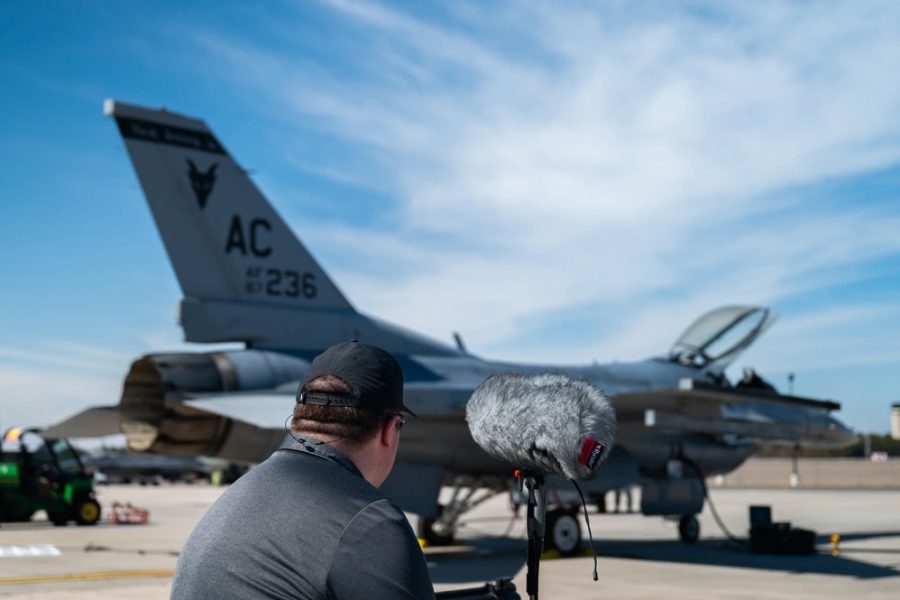F-16s assigned to the New Jersey Air National Guard will live forever in the popular video game Microsoft Flight Simulator, thanks to an audio producer whose goal is to help make virtual flight as realistic as possible.
“It’s not just sound, it’s an experience,” Tyler Bolhuis, CEO and founder of Echo 19 Audio Productions, told Air & Space Forces Magazine. “I’m so passionate about the flight sim environment, and I want other people to experience that excitement.”
Bolhuis visited the 177th Fighter Wing at Atlantic City Air National Guard Base in February to record the sounds that virtual pilots will hear flying the F-16, including cockpit switches and buttons, the battery turning on, the canopy opening and closing, the engines starting up, and the roar of the fighter as it flies overhead at low altitude.
The audio will feature in an upcoming module for the 2024 and 2020 editions of Microsoft Flight Simulator, the best-selling series enjoyed by pilots, aviation fans, and aspiring Air Force aviators alike. Third-party developers—in this case a well-known developer called IndiaFoxtEcho—create and sell add-ons for specific aircraft that users can fly on Microsoft Flight Simulator or other programs.
It is a full-circle moment for Bolhuis, who growing up felt the sound design of flight simulator add-ons often misrepresented the aircraft he heard at airshows.
“Even at a young age, I was like, ‘this just doesn’t sound right,’ which was frustrating after working hard for an allowance to buy an add-on,” he said.
Over time, Bolhuis made a name for himself producing high-quality sound mods for games such as Arma and Digital Combat Simulator, so much so that his hobby became a full-fledged business when he started Echo 19.
“Flight simulation audio is a very niche business, but it’s worked out well so far,” he said. “The graphics look so good in modern-day video games, but sound really drives emotion.”
Bolhuis has recorded C-17s, F/A-18 Super Hornets, F-35s, civilian helicopters and fixed-wing aircraft, and older warbirds such as the P-51. The C-17 in particular is a treat to listen to as all the subsystems on the flight deck power up, he said.

The 177th Fighter Wing was excited about the opportunity and covered the event with a press release and video posted to social media. Bolhuis timed his visit to coincide with scheduled F-16 maintenance and practice flights, so taxpayers did not have to pay for any additional gas or man-hours.
Recording aircraft sounds requires careful planning and familiarity with the aircraft; the ear-shredding roar of a fighter jet engine, for example, requires special microphones that can pick up such a high level of noise in a detailed way.
“You could capture those loud sounds on your iPhone, but it’s going to sound a lot different compared to a $1,000 or $1,500 microphone designed to pick up specific frequencies,” Bolhuis explained.
Each type of engine has unique characteristics: the F-16’s General Electric engine has a slightly different tone while sitting idle or ramping up RPMs compared to the Pratt & Whitney F-16 engine, for example.
“That’s where it becomes really important to know the aircraft that you’re recording,” Bolhuis explained. “We spend a lot of time researching and talking with the developers about the unique features of the aircraft.”
The producer uses multiple microphones to capture those unique sounds, including the way the engine intake sucks in air.
“We essentially create layers so that we can create a mix of certain sounds and frequencies that we want to highlight,” he explained.

Safety comes first, so Bolhuis briefs the plan with the base, the air crew, and the maintainers beforehand. It’s not uncommon for Airmen to recognize the Echo 19 brand and be excited to meet its founder.
“They’re like, ‘whoa, you’re Echo 19?'” he said. “I feel a little out of it because I’m like, ‘oh my God, I’m famous,’” he said.
The Airmen helpfully turned off fans and kept down chatter in the hangar while Bolhuis captured the cockpit noises.
“We’ll get as many as we can, understanding that most of the switches and buttons sound the same,” he explained. “Some of them don’t make sounds, but in video games and flight simulators, we rely on auditory feedback to get a sense that that action has happened.”
The hard work starts when Bolhuis gets back to his home in Michigan to edit the audio, which takes up the vast majority of his time on a project.
“It takes a lot of work to get sounds to translate from the real world into a digital one, but it’s a very rewarding process,” he said.
There has not been a publicly announced release date for the add-on featuring the Jersey Devils F-16s, but when it does come out, the jets should sound just like they did that day in February.
“It’s cool to be able to give these iconic planes the sounds that they truly deserve,” Bolhuis said.
